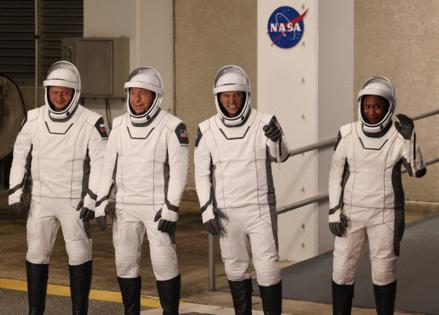NASA's Crew-8 astronauts don't reveal hospitalization details, but discuss strain of Earth return
Published in Science & Technology News
ORLANDO, Fla. — Details were not revealed about who and why one of the three NASA astronauts of the SpaceX Crew-8 mission had to be hospitalized after their return to Earth last month, but all three discussed Friday the slow recovery each faces after spending more than 235 days in space.
“I know there may be some interest in our post-flight medical event, where we diverted to a hospital,” said Michael Barratt, a veteran now of three spaceflights who also served as the crew’s medical officer. “You know, spaceflight is still something we don’t fully understand. We’re finding things that we don’t expect, sometimes. This was one of those times, and we’re still piecing things together on this and so to maintain medical privacy and to let our processes go forward in an orderly manner, this is all we’re going to say about that event at this time.”
Barratt along with with Crew-8 commander Matthew Dominick and mission specialist Jeanette Epps took questions at a press conference from Johnson Space Center in Houston about the mission. Fellow crew member Roscosmos cosmonaut Alexander Grebenkin was not present having returned to Russa. The four launched from Kennedy Space Center back on March 4 for what was supposed to be less than a six-month stay on board the International Space Station and a return in August.
But the delay of Boeing’s Starliner departure from the ISS followed by weather delays including Hurricane Milton caused the quartet to not be able to fly home from the ISS for another two months finally splashing down off the coast of Pensacola on Oct. 25. All three NASA astronauts needed assistance onto an awaiting gurney upon venturing out of the Crew Dragon spacecraft after it was recovered from the waters of the Gulf of Mexico.
NASA said all four crew were taken to Ascension Sacred Heart in Pensacola after landing, and one of the three NASA astronauts had to remain hospitalized overnight. That astronaut was cleared to fly back to Houston the following day.
“I did not say I was uncomfortable talking about it,” Barratt said during the press conference. “I said we’re not going to talk about it. As you may know, I’m a medical doctor. Space medicine is my passion, to be real honest, and how we adapt, how we experience human spaceflight is something that we all take very seriously.”
For now, NASA remains silent on the details, but Barratt said it is something that will help inform future spaceflight.
“In the fullness of time, we will allow this to come out and document it. For now, medical privacy is very important to us,” he said. “We maintain that always in many things. We do the same with due process. So both of those really negate our ability to talk about today. So that’s really it for today.”
He and his two NASA crewmates did discuss the strain all have faced since returning.
“I’ve been fascinated by it,” Dominick said. “And fascinated by the rehab, readaptation … The big things you expect, right? Being disoriented, being dizzy, but the little things like just sitting in a hard chair. My backside has not really sat in a hard thing for 235 days, and as part of some research activities, I’ve had to go sit on a bike for a long period of time, but it’s rather uncomfortable. I did not expect that.”
Both Dominick and Epps said they had times where they would just need to lay down, such as in the middle of family dinner.
“We don’t know how we’re going to respond when we turn we return, and how fast,” Epps said. “Every day is better than the day before. And that’s all we can predict. Every day is better.”
One of Dominick’s experiments in space was to not use the treadmill, but maintain exercise in different ways.
“The last time I walked was when we walked across that causeway into the rocket,” he said. “The first time I walked after that was when we got out of the spaceship.”
Barratt said their long-duration stay feeds more data toward future missions, such as potential human spaceflight to Mars.
“I can tell you that there’s some answers we don’t have,” he said. “We’re pretty good about maintaining bone and muscle in flight now, because of our countermeasure suite.”
That has included now 15 years of work in health metrics addressing bone, muscle, aerobic capacity, immune function all to make life more habitable on the ISS, he said.
“So if you were to ask me, can I countermeasure my way out of zero gravity for the time it takes to get people to Mars and land them safely, I think I would say, ‘Yeah, give me the same loads, the same equipment, and the same time do it, I think we’re kind of there’,” Barratt said.
He said other issues such as radiation and psychological issues, though, remain a challenge.
“Those require other solutions, and those are probably the areas, and I would say food sources, that have to be wholesome for five years. Those are areas where we still have some work to do,” he said.
Their experience during the Crew-8 mission, including the medical incident at the end of it, will just help solve some of those problems.
“We are going to continue to find new things,” he said. “So just kind of expect this road to Mars to be paved with new discoveries, whether we like it or not.”
_____
©2024 Orlando Sentinel. Visit at orlandosentinel.com. Distributed by Tribune Content Agency, LLC.







Comments